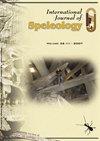J. Michael Queen (1948 – 2019): A Memorial
IF 1.3
4区 地球科学
Q3 GEOSCIENCES, MULTIDISCIPLINARY
引用次数: 0
Abstract
The author’s rights are protected under a Creative Commons AttributionNonCommercial 4.0 International (CC BY-NC 4.0) license. Dr. James Michael Queen of Carlsbad, New Mexico, passed away on August 20, 2019, from pancreatic cancer, at his family’s home in Oak Hill, New York. He devoted most of his life to the innermost processes of speleogenesis. His other interests ranged widely, starting from a foundation in geology and paleontology and branching in many directions through the fine arts and humanities. On the day of his death, he dictated these last few words to his family: Dear Friends, if you are reading this it means that the time on my ticket has expired and I have shuffled on. I don’t know about the when or how of the return trip. As a bat perhaps, or a cephalopod? Or a new biothem [a speleothem built around organic filaments]? Watch for me soon! A close friend, Ron Kerbo (retired Cave Specialist at Carlsbad Caverns National Park), wrote a eulogy that concluded with: He showed us that to be rich is to never stop wondering.... Ron and I collaborated on a remembrance of Michael for the November 2019 NSS News (National Speleological Society, USA). Here I focus on some of his more important work in the field. Born in California in 1948, Michael grew up in New York State and obtained B.A., M.A., and Ph.D. degrees at the State University of New York at Stony Brook, with concentrations in biology and geology. Employment never ranked high among his priorities. He held many part-time jobs throughout the USA, mainly in college teaching and petroleum geology, which gave him the flexibility to pursue geology at his own pace. In 1971 he interrupted his university studies to work for Shell Oil Company, near the cavernous Guadalupe Mountains of New Mexico. On his first caving trips there, he noticed that much of the limestone in the cave walls had been replaced by gypsum, which preserved the textures of the original limestone. This idea launched him on a 40-year study of Guadalupe caves, particularly Carlsbad Cavern. His first interpretation of the interaction between limestone and gypsum was presented at the 1973 NSS Convention and won an award for best scientific paper by a young student. At roughly the same time, the concept of speleogenesis by sulfuric acid was proposed by Stephen Egemeier, also a graduate of State University of New York (New Paltz), from observations in the still-active Kane Caves of Wyoming for his PhD studies at Stanford University. His work was published in 1981 and helped to steer Guadalupe researchers in the same direction. Michael and one or two fellow researchers (e.g., Donald Davis of Colorado) also considered sulfuric acid to be a factor in late-stage modification of the Guadalupe caves; but further observations convinced him that, in fact, most of the cave enlargement was the work of sulfuric acid. Michael wrote few technical papers, but they described speleogenetic processes with unusual clarity. His interpretations tend to follow paths independent from other researchers. For example, he stressed the importance of cave enlargement by sulfuric acid above the water table long before the concept became well accepted. He was not the first to conceive of some of these concepts, but he expanded on them independently and helped to explain them to others. A prominent feature in Carlsbad Cavern is a spongelike zone of bedrock called the Boneyard, which was long considered an iconic example of phreatic dissolution. On the basis of morphology, air patterns,J.Michael Queen(1948–2019):纪念馆
作者的权利受到知识共享署名非商业4.0国际(CC BY-NC 4.0)许可证的保护。来自新墨西哥州卡尔斯巴德的詹姆斯·迈克尔·奎因博士于2019年8月20日因胰腺癌癌症在纽约橡树山的家中去世。他一生的大部分时间都致力于洞穴形成的最深层过程。他的其他兴趣广泛,从地质学和古生物学的基础开始,到美术和人文学科的多个方向。在他去世的那天,他向家人口述了最后几句话:亲爱的朋友们,如果你读到这篇文章,那就意味着我的机票时间已经到期,我已经拖着脚走了。我不知道回程的时间和方式。也许是蝙蝠,还是头足类动物?还是一种新的生物群[围绕有机细丝建造的洞穴]?小心我!一位亲密的朋友Ron Kerbo(卡尔斯巴德洞穴国家公园的退休洞穴专家)写了一篇悼词,最后写道:他向我们展示了致富就是永不停止的好奇。。。。罗恩和我合作为2019年11月的NSS新闻(美国国家语言学会)纪念迈克尔。在这里,我将重点介绍他在该领域的一些更重要的工作。迈克尔1948年出生于加利福尼亚州,在纽约州长大,在纽约州立大学石溪分校获得了学士、硕士和博士学位,专注于生物学和地质学。就业从来都不是他的首要任务。他在美国各地从事过许多兼职工作,主要从事大学教学和石油地质学,这使他能够灵活地按照自己的节奏从事地质学工作。1971年,他中断了大学学业,在新墨西哥州洞穴状的瓜达卢佩山脉附近的壳牌石油公司工作。在他第一次去那里探险时,他注意到洞穴壁上的大部分石灰石都被石膏取代了,石膏保留了原始石灰石的质地。这个想法促使他对瓜达卢佩洞穴,特别是卡尔斯巴德洞穴进行了40年的研究。他对石灰石和石膏之间相互作用的第一次解释是在1973年的NSS大会上发表的,并获得了一名年轻学生的最佳科学论文奖。大约在同一时间,同样毕业于纽约州立大学(New Paltz)的斯蒂芬·埃格梅尔(Stephen Egemeier)在斯坦福大学攻读博士学位时,根据对怀俄明州仍然活跃的凯恩洞穴的观察,提出了硫酸洞穴形成的概念。他的工作发表于1981年,并帮助指导瓜达卢佩的研究人员朝着同样的方向发展。Michael和一两位同事(例如科罗拉多州的Donald Davis)也认为硫酸是瓜达卢佩洞穴后期改造的一个因素;但进一步的观察使他相信,事实上,大部分洞穴扩大都是硫酸造成的。迈克尔写的技术论文很少,但他们以不同寻常的清晰度描述了洞穴形成过程。他的解释往往遵循独立于其他研究人员的路径。例如,早在这个概念被广泛接受之前,他就强调了通过地下水位以上的硫酸扩大洞穴的重要性。他不是第一个构思其中一些概念的人,但他独立地对这些概念进行了扩展,并帮助向其他人解释这些概念。卡尔斯巴德洞穴的一个突出特征是一个被称为Boneyard的海绵状基岩区,长期以来被认为是潜水溶解的标志性例子。在形态学、空气形态、,
本文章由计算机程序翻译,如有差异,请以英文原文为准。
求助全文
约1分钟内获得全文
求助全文
来源期刊

International Journal of Speleology
地学-地球科学综合
CiteScore
3.10
自引率
23.10%
发文量
12
审稿时长
>12 weeks
期刊介绍:
The International Journal of Speleology has the aim to get cave and karst science known to an increasing number of scientists and scholars. The journal therefore offers the opportunity to all scientists working in and on karst to publish their original research articles or their review papers in an open access, high quality peer reviewed scientific journal at no cost. The journal offers the authors online first, open access, a free PDF of their article, and a wide range of abstracting and indexing services.
 求助内容:
求助内容: 应助结果提醒方式:
应助结果提醒方式:


